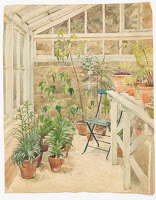The Cedars Oil on canvas c.1924 Photograph ©Liss Llewellyn. Private collection
This is The Cedars, the Dunbar family home from 1924-46, most likely painted when Evelyn was 17. It's maybe not the most engaging painting to emerge from her juvenile studio, even from one who never showed much interest in painting buildings for their own sake, but it's an honest and workaday account of her new home. She kept it for the rest of her life, the only formal painting of any house she ever lived in.
The Cedars, surely photographed some years before the exterior embellishments in Evelyn's rendering above.
The Cedars stood - and still stands - on rising ground in Strood, westernmost of the Medway Towns, across the river from Rochester. It was built some time after 1860 on the site of a windmill. Evelyn's
father William Dunbar bought it in 1924 for £1800, a knockdown price,
according to Alec Dunbar, which equates roughly to £110,000 today. Alec,
the younger of Evelyn's two brothers, recorded this and other early
insights into the Dunbar family in a racily breathless manuscript memoir
entitled Never a Dull Moment.
The tower, and the possibility of converting it into a studio, initially for his wife Florence and in due course for Evelyn, was probably a powerful factor in William Dunbar's decision to buy the property. It was high time: Florence's studio, improvised in the 'snug', a sort of fore-kitchen in the previous family house at 244, High Street, Rochester, was hardly conducive to serious painting, as an early drawing of Evelyn's shows:
The Artist and her Mother in the 'Snug' c.1922 pen and ink on paper Photograph ©LissLlewellyn
It's difficult to gauge the 'feel' of the interior of The Cedars from Evelyn's brush or pencil. She was never very interested in interiors. The people in them, yes, certainly, but rarely do we have an interior for its own sake. Our closest glimpse inside The Cedars comes perhaps in A Knitting Party, a 1940 painting for the War Artists' Advisory Committee, and even then Evelyn has enlarged the room with non-existent walls and bays in order to cram all the knitters in without jeopardising the balance of the painting.
Occasional images amplify the interior of The Cedars, but so little that I hesitate to include any. Here are two of several:
Interior at The Cedars c. 1925 pen, ink and wash. Photograph©Liss Llewellyn
Sharp-eyed Dunbar aficionados may recognise this as the setting for Evelyn's 1930 Sketch for Decoration: Flight now (with the addition of Jessie Dunbar playing solo badminton) in Tate Britain.
* * *
William Dunbar died aged 70 in 1932. The rest of the family continued to live there until Alec left on his marriage in 1936. Florence died in 1944, Evelyn, the youngest of the siblings, left to live in Warwickshire with her husband Roger Folley in 1945. The three survivors, Ronald, Jessie and Marjorie, all unmarried, sold The Cedars in 1946 and went to live across the river in nearby Rochester.
For a while, and before it was converted into flats, The Cedars became a hotel, and indeed for a long time afterwards an exterior bracket lamp, visible from the road outside, carried - and maybe still carries - the legend 'The Cedars Hotel', the only remaining glimpse into its past.
As for the garden, not the slightest trace remains. It was laid to rest beneath the foundations, drains and infrastructure of an overcrowded, cheek-by-jowl housing estate. It only lives on through Evelyn's images of it, subject of the next post in this series.
(Text © Christopher Campbell-Howes 2019. All rights reserved.)
Further reading...
EVELYN DUNBAR : A
LIFE IN PAINTING
by Christopher Campbell-Howes
is available to order online from:
by Christopher Campbell-Howes
is available to order online from:
Casemate Publishing | Amazon UK | Amazon US
448 pages, 301 illustrations. RRP £30
448 pages, 301 illustrations. RRP £30







No comments:
Post a Comment